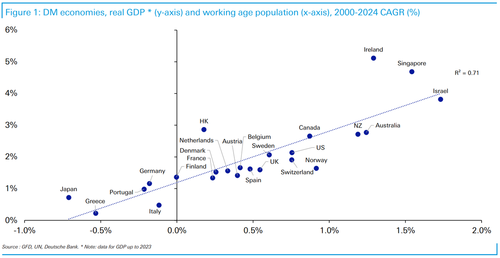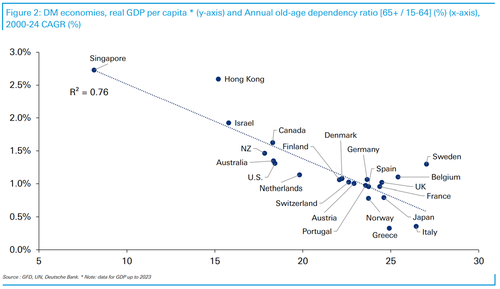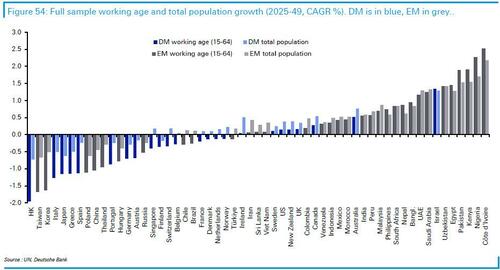What Global Growth Looks Like In The Coming Demographic Collapse
It is safe to say that immigration was one of the top factors - if not the most important one - that shaped the outcome of the US presidential election. It is also safe to say that the past, present and future demographic layout of any given country, region and continent is what determines and defines immigration policy, both in the US and everywhere else... we did just that back in May
demographics shape global immigration policies pic.twitter.com/IisdB9rvp6
— zerohedge (@zerohedge) May 27, 2024
Which is why we were delighted to see that the core topic of Deutsche Bank's latest long-term study, one looking at the numerous socio-economic transformations during the first Quarter Century of the 21st century, the most important variable was demographics. Specifically, report author Jim Reid showed how the period 2000-2024 was a transitional period for many countries between total and/or working age population growth and decline.
We will share a much more detailed analysis of the report in the coming days, but wanted to share the following anecdote: in the developed world sample, there was a strong correlation between both total and working-age population growth and GDP growth over the 2000-2024 QC. The chart below shoes this for the working-age population, and interestingly the five countries that had a decline in the quarter century all saw the lowest annual GDP growth.
Intuitively, the correlation makes sense, as the number of workers is a key component of headline economic growth. However, the correlation is so strong that one can make some assumptions about the future based on what we know about likely demographic changes going forward. (there is much more in the full report on pp.33-41 on this topic available to pro subscribers).
Of course, one can argue that per capita growth is more important for living standards. Which brings us to the next chart: although the correlation isn’t as strong as with actual real GDP it is still impressive. If one excludes the small open economies of Ireland, Singapore and HK, the R-squared increases to 0.59.
So, as Jim Reid notes, we have compelling evidence that declining demographics not only impact real GDP, but also per capita growth too, and he adds that he is "not sure this is widely appreciated, especially in the migration debate."
We would counter that it is very appreciated, especially by globalists who are desperate to flood developed countries with immigrants from poor but growing parts of the world (mostly Latin America and Africa), but as recent elections have shown - in which the incumbent parties have suffered historic losses in 2024 as all have pushed for an aggressive immigration regime...
... the social upheaval and chaos that results from mass importation of immigrants is just not viewed as an equitable offset to the potential for higher growth some time in the future (especially now that people have hope that AI will spawn a productivity revolution which could push GDP sharply despite shrinking populations).
As to why declining populations lead to economic contraction, Reid explains that a big part of this is that as demographics deteriorate, the population becomes less dynamic. Maybe a large part of this is financing an ageing population. Almost by definition, those countries that have deteriorating demographics will have an ever larger older population. So the reason per capita growth might not be strong is that a lot of resources are likely being directed to those beyond working age which will obviously be costly.
As a bonus chart, we show annualized per capita GDP growth in the 2000-2024 QC against the dependency ratio at the end of 1999. This ratio is the percentage of the population aged over 65 relative to those aged between 15-64 (working age). Clearly, the inverse correlation is very strong.
So from this evidence it’s difficult to suggest that you can have strong growth in living standards without a growing working-age population.
As a final bonus chart, Deutsche Bank shows that of the 57 DM and EM economies uses in the study, there isn’t a single one that has a better dependency ratio at the end of 2024 than they did at the end of 1999.
Obviously if in 2050 the working-age population has been extended out by several years through policy, this could help economic growth. However, Reid cautions that "if that proves politically impossible we will need to rely on immigration or productivity growth." Needless to say, the former is "a zero sum game globally, and domestically a political hot potato at the moment." Which only leaves productivity... which means that AI, LLMs and chatGPT are the last remaining hopes, and better not be one giant hype bubble, or else the global growth in the next 25 years is toast, and the only remaining fallback is a familiar one: borrowing even more from the future, and even more record debt. Either that, or there is another mass "culling" event which eliminates the elderly and sparks another global baby boom... something like World War 2.
Fuil Deutsche Bank report on Lessons from the 1st Quarter Century of the Millennium available to pro subscribers.







